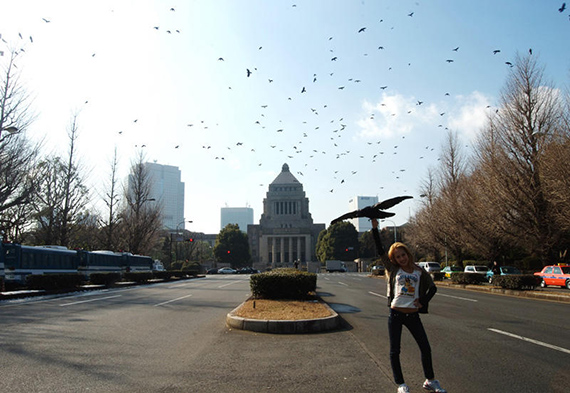
BLACK OF DEATH 2008
Lambda print, video
81 x 117.5 cm (photo), 9 min. 13 sec. (video)
Courtesy: ANOMALY and MUJIN-TO Production, Tokyo
Chim↑Pom »
Happy Spring
Exhibition: 18 Feb – 29 May 2022
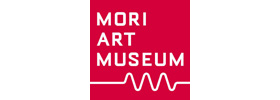
Mori Art Museum
6-10-1 Roppongi, Minato-ku
106-6150 Tokyo
+81-3-57778600
Sun-Thu 10-22 . Fri, Sat 10-24
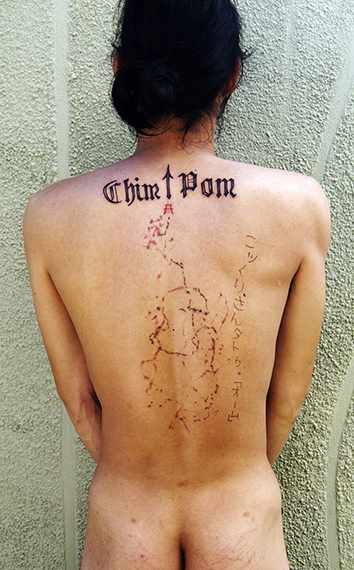
KOKKURISAN TATTOO 2008
Lambda print 83 x 52 cm
Courtesy: ANOMALY and
MUJIN-TO Production, Tokyo
Equipped with highly original ideas and impressive energy, artist collective Chim↑Pom has undertaken numerous projects intervening in society in ways that constantly confound our expectations. With themes ranging from cities and consumerism to gluttony and poverty, Japanese society, the atomic bomb, earthquakes, images of stardom, the mass media, borders, and the nature of publicness, their works serve as powerful statements on a plethora of phenomena and challenges in modern society, delivered mostly with a healthy dose of humor or irony.
With seemingly uncanny foresight, Chim↑Pom has also addressed in a number of their previous works the social issues of infection and discrimination against people with contagious diseases, and of bias, contamination and borders, all thrown into sharp relief by the COVID-19 pandemic. Now more than ever perhaps is the time to observe their thought-provoking knack for raising issues pertinent to the zeitgeist.
This will be the first-ever retrospective of Chim↑Pom, bringing together major works from the start of their seventeen-year career to more recent years, plus new work produced for this exhibition. Artworks will be arranged by theme - e.g., cities and publicness, Hiroshima, the Great East Japan Earthquake - highlighting matters consistently addressed by the artists, while examining the collective’s oeuvre in its entirety. Dynamic exhibition design, rich in creative ingenuity, will also assist in shedding new light on the ever-surprising world of Chim↑Pom.
The title Happy Spring signals Chim↑Pom’s hope for a brighter spring even amid this seemingly neverending pandemic, and that we retain our powers of imagination even if that long-awaited season arrives in the depths of adversity. In these unpredictable times, the powerful, convention-busting works of this enduring, but equally-unpredictable group of artists are certain to excite the imagination, and serve as a guide as we join in contemplating a better future.
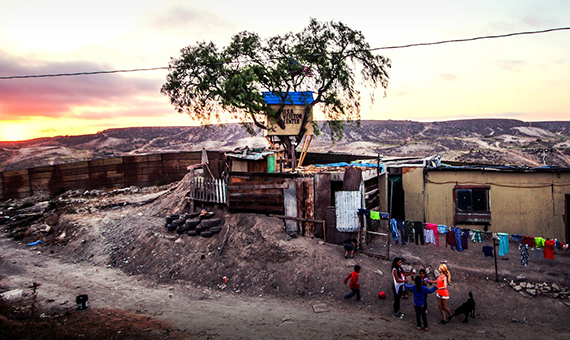
U.S.A. Visitor Center (from the project “The other side” ) 2017
Giclee print
66 x 100 cm
Courtesy: ANOMALY and MUJIN-TO Production, Tokyo
Photo: Matsuda Osamu
Everything from Earliest to High-Profile and New Works in a Single, Comprehensive Retrospective
Chim↑Pom: Happy Spring will bring together a large selection of the extraordinary sextet’s best-known work, from early classic “Thank You Celeb Project I’m BOKAN” (2007) to the A-bomb-themed Making the Sky of Hiroshima “PIKA!” (2009) and LEVEL 7 feat. “Myth of Tomorrow” (2011); numerous larger works such as the “Build-Burger” series (2016/2018); small, humorous pieces, and an array of immersive/ experiential works, in what will be the world’s first comprehensive retrospective exhibition of work by the internationally renowned Chim↑Pom.
The Exhibition Personally Designed by the Artists to Astound and Delight!
This will be distinctly different to the usual, chronologically-arranged retrospective. Works will be exhibited by themes such as cities and publicness, the physical body, and borders, and multiple viewing routes provided to encourage diverse readings of the exhibition. Visitors will also find themselves plunged into some dynamic exhibition spaces, including one with asphalt, and an entire gallery composed into a single giant installation featuring multiple works. A fascinating lineup of events and actions is also planned on site for the duration of the exhibition.
Two Newly-Commissioned Works, Including an On-Site Nursery
The exhibition will include a new video installation conceived around the event of Ellie giving birth in 2020. A nursery (daycare center) will also be set up at the exhibition, in a new art project “Crying Museum” inspired by the child-raising challenges of Chim↑Pom’s generation. The idea is to enable more people to view the exhibition, while simultaneously raising awareness of difficulties for young families in Japan.
Joining Visitors to Ponder the Concept of “Publicness”
Not long ago, Chim↑Pom built a private road in the grounds of their studio on private land, allowing anyone to pass through. In Taiwan, they created a long street passing through the interior and outdoor spaces of an art museum, and formulated a set of original rules to apply there. By this use of the “street” as a theme, they urge us to turn our thoughts to matters of “publicness,” and “the public and individual.”
Revisiting Debates and Dialogues around Works by Chim↑Pom
Some of Chim↑Pom’s past projects have ignited debate, those on Hiroshima and the Great East Japan Earthquake proving particularly controversial. This exhibition will revisit such controversies, examining them from multiple viewpoints and presenting not only the works themselves but timelines and related material, and setting out the arguments for and against the works.
Things Revealed 10 Years on from the 2011 Quake, and Now amid a Pandemic
Ever since the 2011 Great East Japan Earthquake, Japanese artists have been working more than ever to help build a better society, and Chim↑Pom is no exception, undertaking multiple projects after the disaster. Now, ten years on, they will revisit these projects.
It so happens that a number of Chim↑Pom’s projects of the past decade, such as the “border”-themed project carried out on the Mexico-US border in 2016-2017, and their large-scale participatory project at the 2019 Manchester International Festival, which dealt with the historical connection between a 19th-century cholera epidemic in the city, and beer, unintentionally deal with social issues highlighted by the COVID-19 pandemic. Chim↑Pom also continues their sharp observations on the state of Japanese society, for example, in a new work set in Tokyo during 2020’s State of Emergency. Chim↑Pom: Happy Spring is designed to provide a platform for discussing these and other Chim↑Pom activities, with reference to the current social climate.
Exhibition Themes
1. Cities and Publicness
Chim↑Pom has favored urban settings for many of their projects right from the beginning. In Gold Experience (2012), for example, they turned a garbage bag into a gigantic, fun piece of sculpture. More recently, their focus on cities has developed further to encompass discussions of urban theory and commonality / publicness, including in the “Scrap & Build” projects (2016-2017), Street (2017-2018), and “A Drunk Pandemic” (2019-2020).
2. The Physical Body
Physical expression is fundamental to Chim↑Pom, and has been from the collective’s early days, when they took to the streets armed with nothing more than themselves and a video camera. Advances in CG technology mean that now they could probably produce works without actually using their bodies, but for the members of Chim↑Pom, the body itself remains central to artistic expression, even if that means tattooing their flesh, fasting, or repeated vomiting. It is this very realness that has the power to astound.
3. Borders
Since 2014, Chim↑Pom has been engaged in “The other side” series dealing with the problem of America’s southern border. The title is taken from the name commonly used for the US by those living on the Mexican side. The Chim↑Pom team also conceived the idea for Don’t Follow the Wind (March 11, 2015-), an international exhibition in the Fukushima exclusion zone that “no one can actually go see” until the ban on return is lifted, and has been participating as artists themselves. “Borders” is one of the themes that Chim↑Pom has tackled consistently throughout the years, and one perhaps even more important than ever in these pandemic days of lockdowns and restricted mobility.
4. Hiroshima
Making the Sky of Hiroshima “PIKA!” (2009) is a work that captures the moment in 2008 when the artists chartered a skywriting plane to write the word “Pika” (evoking the flash of the bomb) above the A-Bomb Dome in Hiroshima. The artists’ intention was to render visually, and in comic-book style, the growing indifference to the peace on which contemporary Japanese society is founded, but when misunderstanding and speculation were added to the mix, the result was controversy. Having apologized to A-bomb survivors, their families and supporters for not giving sufficient advance notice of the stunt, Chim↑Pom has subsequently continued to converse and occasionally collaborate with them and the wider Hiroshima community on a number of projects. Subsequent Hiroshima-themed works include Pavilion (2013-) and Non-Burnable (2017) both featuring origami paper cranes, plus the still-burning flame from the bomb in We Don’t Know God (2018).
5. The Great East Japan Earthquake
In the immediate wake of 2011’s devastating Great East Japan Earthquake, Chim↑Pom undertook a number of projects related to the quake, tsunami, and subsequent nuclear power plant accident. Starting with Never Give Up (2011), this period saw the emergence of some of their best-known works such as REAL TIMES (2011) and KI-AI 100 (2011), while in LEVEL 7 feat. “Myth of Tomorrow” (2011) they added, guerilla-fashion, a picture showing the accident at the Fukushima Daiichi Power Plant, in a blank space at the lower right of Okamoto Taro’s Myth of Tomorrow mural in Shibuya Station. An ongoing project in the quake exclusion zone, among other quake-related ventures, indicates that a decade on the disaster remains an important theme for Chim↑Pom.
6. May, 2020, Tokyo
Chim↑Pom installed billboards painted with cyanotype sensitizer in various locations around the capital for a project undertaken in May 2020, during Japan’s COVID-19 State of Emergency. The texts “Tokyo 2020” and “Atarashii Seikatsu-Youshiki (New normal)” on these were designed to be unexposed, and left white. Incorporating sun, shadow, wind and rain, these works could be described as the open air and time, etched in blue, of streets almost deserted during the state of emergency, when people were urged to “stay at home.” With deceptive simplicity, these works express the bizarre reality of Tokyo whose blueprint for a bright future was now lost.
7. Ellie
Through her actions over the years, including a Cambodian mineclearing and fundraising project with a theme of charity and celebrity culture; and applying to city authorities for permission to stage a demonstration, then staging a wedding parade for herself through the streets in a social scrutinizing of the marriage system, Chim↑Pom member Ellie has consistently offered new perspectives on some of the world’s most deep-rooted social issues. From occasional appearances in the mass media, where she is viewed as a pop icon, to authorship of high-brow articles for a literary magazine, and everything in between, Ellie’s activities, and indeed the very nature of her presence, defy categorization. At first glance she may also seem to serve as the face of Chim↑Pom, but in this show we examine the many aspects of Ellie that do not fit neatly into conventional gender norms, feminist discourse, or the usual image of an artist.
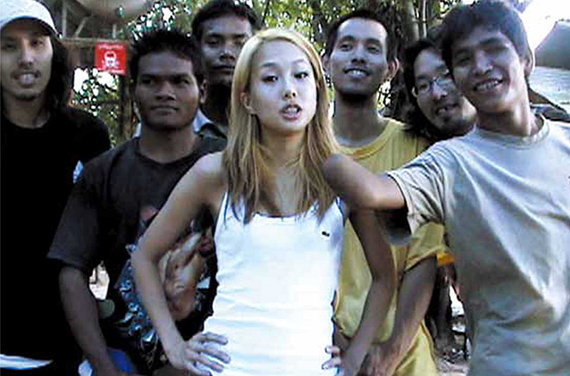
SPEECH (from the project “Thank You Celeb Project I’m BOKAN” ) 2007
Video 1 min. 53 sec.
Courtesy: ANOMALY and MUJIN-TO Production, Tokyo
Production view: Shinjuku, Tokyo